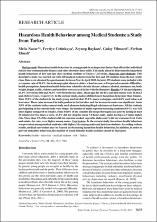| dc.contributor.author | Naçar, Melis | |
| dc.contributor.author | Çetinkaya, Fevziye | |
| dc.contributor.author | Baykan, Zeynep | |
| dc.contributor.author | Yılmazel, Gülay | |
| dc.contributor.author | Elmalı, Ferhan | |
| dc.date.accessioned | 2019-05-13T09:04:24Z | |
| dc.date.available | 2019-05-13T09:04:24Z | |
| dc.date.issued | 2015 | |
| dc.identifier.citation | Nacar, M., Cetinkaya, F., Baykan, Z., Yılmazel, G., Elmalı, F. (2015). Hazardous health behaviour among medical students: a study from Turkey. Asian Pacific Journal of Cancer Prevention, 16(17), 7675-7681. | en_US |
| dc.identifier.issn | 1513-7368 | |
| dc.identifier.uri | https://doi.org/10.7314/APJCP.2015.16.17.7675 | |
| dc.identifier.uri | https://hdl.handle.net/11491/1585 | |
| dc.description.abstract | Background: Hazardous health behaviour in young people is an important factor that affects the individual risk for non-communicable diseases and other disorders later in life. This study aimed to determine the hazardous health behaviour of first and last class medical students of Erciyes University. Materials and Methods: This descriptive study was carried out with 240 medical students from the first and 130 students from the last (sixth) class. Data were obtained by questionnaire between March-April 2012. In total, 339 students were included with a response rate of 91.6%. Socio-demographic characteristics, school success, self-reported economic difficulties, health perceptions, hazardous health behaviour related to chronic disease, tobacco, alcohol, substance use, body weight, height, traffic, violence and nutrition were assessed in line with the literature. Results: Of the participants; 64.0% were from first and 36.0% were from the last class. Mean ages for the first and last classes were 19.4±1.5 and 24.0±1.5 years, respectively. In the current study, males exhibited more hazardous behaviour than females. Sime 19.8% of the students in the study group used alcohol, 35.4% used a waterpipe, and 24.8% used tobacco at least once. These rates increased in both genders in the last class and the increase in males was significant. Some 3.8% of the students in the current study used pleasure-inducing illegal substances at least once. All the students participating in the current study were single, the number of males reported not using condoms (8.6%) was 4.56 times higher compared to females. Some 64.0% of the students did not perform physical activity lasting at least 30 minutes for five times a week, 13.0% did not sleep for mean 7-8 hours daily, males having a 2.9 times higher risk. More than 1/3 of the students did not consume cooked vegetable dishes and 1/4 did not consume fresh fruits and salads, the rates were higher among males. Conclusions: In the current study, hazardous health behaviour was prevalent among medical students, with higher risks among males and last class students. According to these results, medical curriculum may be focused on decreasing hazardous health behaviour. In addition, in order to prevent unhealthy behaviour, the number of youth-friendly health facilities should be increased. | en_US |
| dc.language.iso | eng | |
| dc.publisher | Asian Pacific Organization for Cancer Prevention | en_US |
| dc.relation.isversionof | 10.7314/APJCP.2015.16.17.7675 | en_US |
| dc.rights | info:eu-repo/semantics/openAccess | en_US |
| dc.subject | Behaviour | en_US |
| dc.subject | Health | en_US |
| dc.subject | Medical Students | en_US |
| dc.subject | Risk | en_US |
| dc.subject | Turkey | en_US |
| dc.title | Hazardous health behaviour among medical students: a study from Turkey | en_US |
| dc.type | article | en_US |
| dc.relation.journal | Asian Pacific Journal of Cancer Prevention | en_US |
| dc.department | Hitit Üniversitesi, Sağlık Bilimleri Fakültesi, Hemşirelik Bölümü | en_US |
| dc.authorid | 0000-0002-2487-5464 | en_US |
| dc.identifier.volume | 16 | en_US |
| dc.identifier.issue | 17 | en_US |
| dc.identifier.startpage | 7675 | en_US |
| dc.identifier.endpage | 7681 | en_US |
| dc.relation.publicationcategory | Makale - Uluslararası Hakemli Dergi - Kurum Öğretim Elemanı | en_US |


















